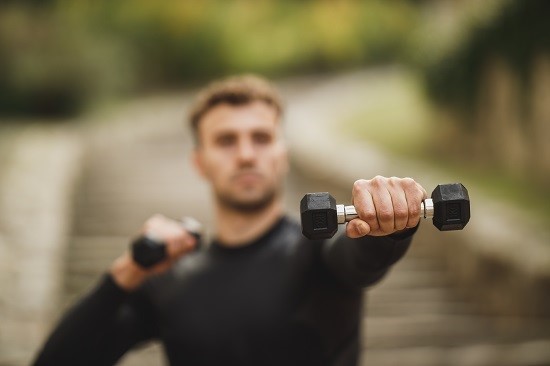There have been many fads and diets over the years that claim
to help with
weight loss. Although some may have benefits, there is no real
substitute to exercise. Aside from weight loss, exercise is crucially important
to maintaining overall health and preventing disease.
اضافة اعلان
In most cases, cardio exercises have been the primary fitness
regimen to help lose weight. Unfortunately, due to the time and energy cardio
takes, many find it difficult to turn into a long-standing habit. However, in
the past few decades, many have tried to change this by introducing new
workout regimens such as the high-intensity interval training or HIIT for short.
What is HIIT?
HIIT was designed by Dr Izumi Tabata in 1996. It is a workout
regimen that focuses on burning calories by incorporating strength and cardio
exercises. As the name suggests, HIIT works by alternating between
high-intensity workouts and low-intensity workouts.
During the periods of high intensity, you should be working
at 80–90 percent of your maximum capacity, and during the low-intensity periods
you should be working at around 60 percent. You should try to maintain a 1:2
ratio of high and low intensity periods.
A typical HIIT workout lasts 15–30 minutes and should be
followed by a recovery day. In total, HIIT is done 3-4 days a week on
alternating days.
How does it work?
While HIIT is an excellent form of exercise, it gained
popularity as a way of losing weight. The specifics of how HIIT helps burn fat
is still being fully researched, but there are many studies that offer an
explanation.
 (Photo: StockSnap)
(Photo: StockSnap)
The foremost theory pertains to aerobic and
anaerobic exercise. The former means that your body and cells are still receiving enough
oxygen to produce energy normally. The latter means your body is “overworked”,
and unable to deliver sufficient oxygen to the cells; as a result, it falls
back on other energy sources, like fat, researches believe. Although periods of
anaerobic exercise are short, the body adapts to the situation and continues to
burn fat rather than carbohydrates for up to 24 hours.
Additionally, HIIT is believed to increase the metabolism.
Studies have shown that HIIT can increase the rate at which human growth
hormone is produced by 450 percent for 24 hours. This hormone plays an
important role in metabolism and after consistent HIIT workouts, it can
increase your overall metabolism.
Benefits
One of the biggest benefits of HIIT is how easy it is to
follow. HIIT takes a maximum of 45 minutes a day and is done every other day. Studies
have shown that one of the most common reasons for not exercising is time and
the limited time required for HIIT can be appealing to busy people. In addition
to short time, it is also highly effective at
burning calories. Studies have
found that HIIT burns 25–30 percent more calories than other forms of exercise.
In short, it can burn more calories than other workouts or burn the same amount
of calories but in a shorter amount of time.
Aside from HIIT’s ability to burn fat and increase
metabolism, there are other advantages that HIIT has compared to
traditional diet and exercise. Firstly, HIIT can help you gain or maintain muscles. Although
this is true for nearly all forms of exercise, for those dieting, muscle loss
is more likely. With HIIT, however, strength training is incorporated into the
workouts and weight loss is effective enough that diets do not have to be as
strict. A less strict diet will give your body all the nutrients needed to
maintain or gain muscle mass. With that being said, if you are looking to lose
weight, your calories should still be counted and maintained as a deficit.
Additionally, HIIT has the added benefit of controlling and or reducing
blood sugar. Insulin is a hormone produced in the body and is responsible for controlling
blood sugar. For those who have insulin resistance, this is known as type 2
diabetes. Numerous studies have shown that HIIT is capable of reducing blood
sugar, as well as improving insulin resistance. This can prove to be especially
beneficially to those at risk for type 2 diabetes or those already diagnosed
with it.
 (Photo: StockSnap)
(Photo: StockSnap)
Lastly, HIIT brings with it the many benefits that come with
regular exercise. Research on
blood pressure and heart rate in the overweight
and obese population has shown that HIIT programs can reduce both. This is an
important advantage considering that high blood pressure is common in this
population. Similar to burning calories, the effects of blood reduction in HIIT
is equivalent to that of traditional exercises. One study found that an
endurance training regimen done for 30 minutes a day, 4 times a week had
similar reductions in blood pressure to that of a HIIT program done only 20
minutes a day, 3 times a week. Additionally, HIIT programs allow your bodies to
consume oxygen more efficiently. This is due, in part to, the changes between
anaerobic and aerobic exercise. Improved oxygen consumption is traditionally
found in endurance exercises but with HIIT, nearly equal levels of improvement
can be seen in only half the time.
How to Start HIIT
There are many regimens available that can cater to each
individual. It is first important to determine if you are eligible to perform
HIIT. HIIT requires continuous vigorous activity which may be inappropriate for
certain individuals. If you have any concerns, you can consult your doctor or a
fitness coach. Additionally, you will need to take some baseline measurements
before you start in order to gauge your maximum. There are many metrics that
can be used although
heart rate tends to be the best. There are many wearable
devices that can monitor your heart rate while you exercise such as
smartwatches but counting your pulse manually is also a viable substitute. Alternatively, you
can use perceived exertion which is your own subjective evaluation of how hard
you are working. You will also need to have some way to keep track of time.
The best part of HIIT is how easily tailored it can be. If
you enjoy running, a HIIT program can be design solely around it. Once you have
determined the
exercises you would like to perform, it is to have a warmup and
a cool down. The best way to do this is by doing a less strenuous version of
your intended workout. For example, if your program is running based, start and
end your work out with a light jog for 10 minutes prior and after. While
performing the HIIT aspect of the program it is important to alternate between
high-intensity (e.g., 80–90 percent of maximum heart rate) and low-intensity
(60 percent of maximum heart rate). HIIT is insensitive which means you will
likely become sore. Recovery days are important to allow time for your body to
heal but it many recommend not resting. It is believed that light exercise such
as walking can help with recovery time.
Read more Health



